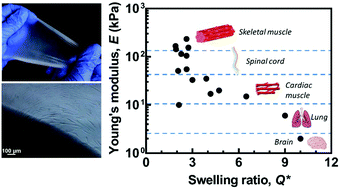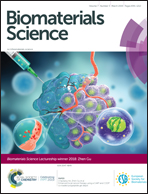Polypeptide-affined interpenetrating hydrogels with tunable physical and mechanical properties†
Abstract
Novel hydrogels with tunable mechanical properties similar to human soft tissue have increasing applications in biomedicine, soft robotics, and biocompatible electronics. However, most of these materials require multiple-step fabrication, are not robust, and compromise bioactivity. Thus, aiming to address these shortfalls, herein, we report a versatile hydrogel system with tunable properties and a facile one-pot fabrication process. The hydrogel system is comprised of a hydrogen-bonded hydrophilic polyurethane (HPU) network and a loosely crosslinked copolymer crosslinked with long chain crosslinkers and decorated with succinimide groups. The active succinimide sites conjugate to proteins, such as bovine serum albumin as a model protein, providing additional biocompatibility and controlled release of growth factors and peptides. The interpenetrating nature of this hydrogel system provides a high degree of freedom over mechanical and physical properties by adjusting the ratio of networks and the composition of the second network. Through this process, a library of biocompatible hydrogels with stiffness ranging from 1 to more than 200 kPa was developed. Moreover, it was found that the succinimide groups impact the degree of crosslinking and contribute to the controlled release of peptides.



 Please wait while we load your content...
Please wait while we load your content...